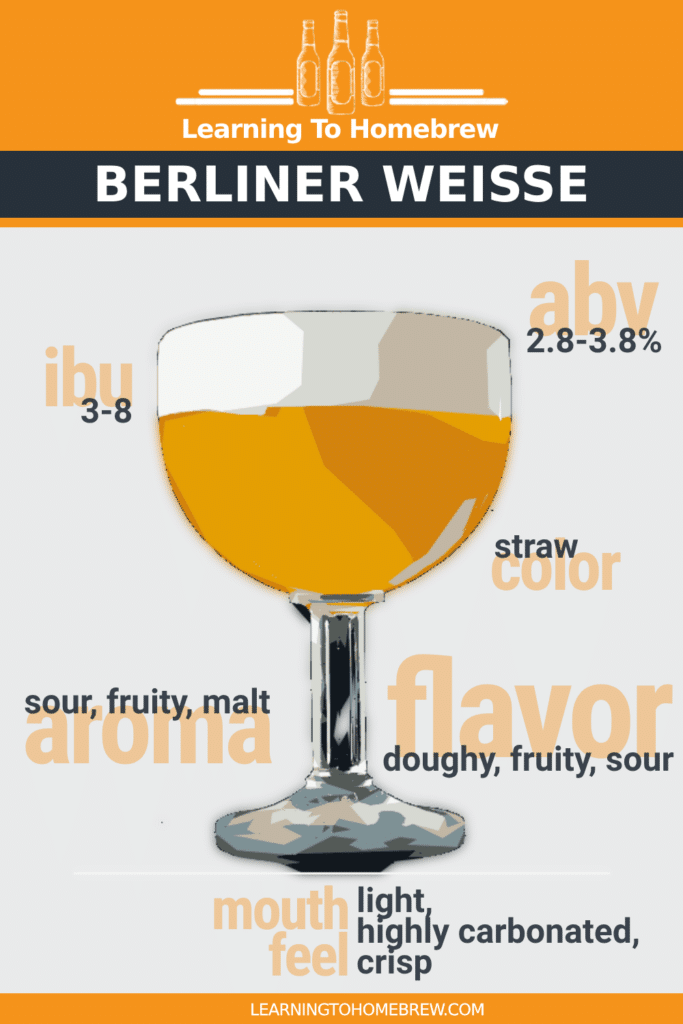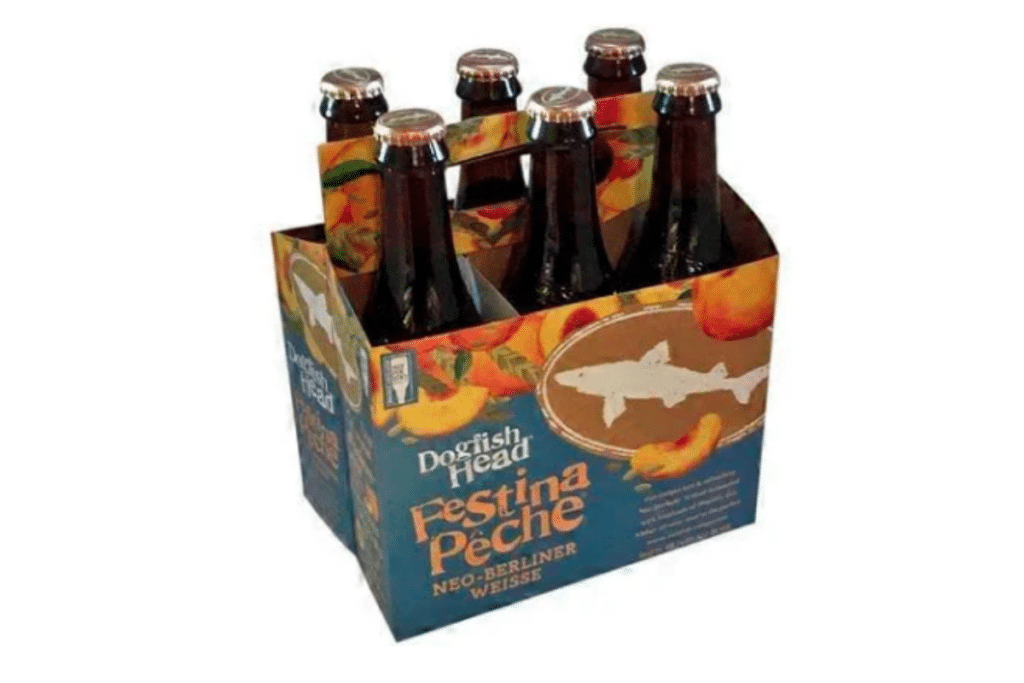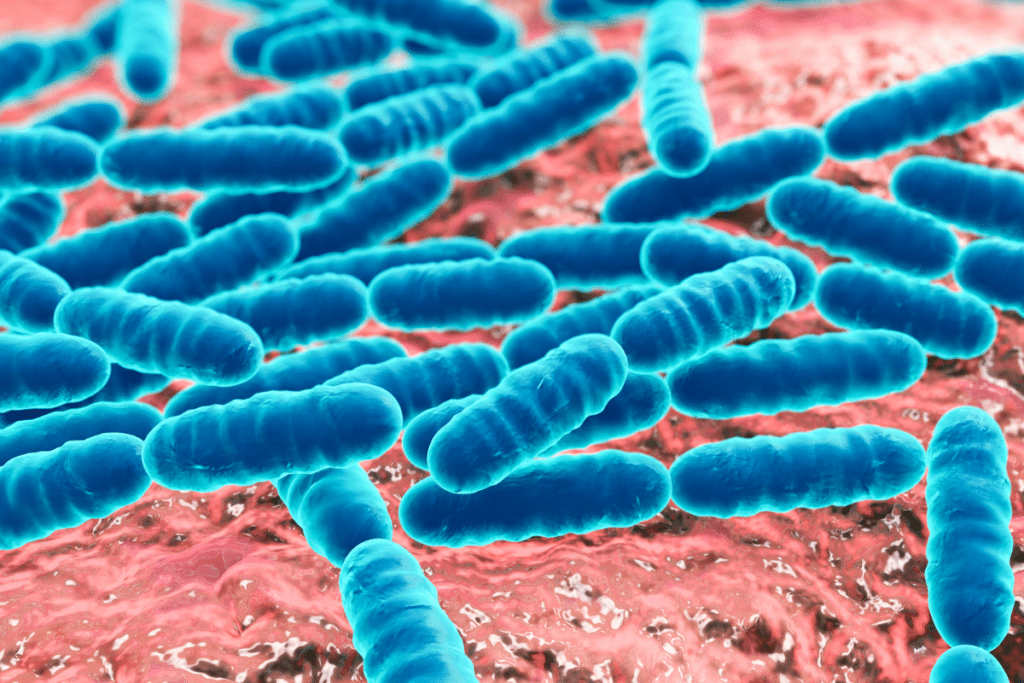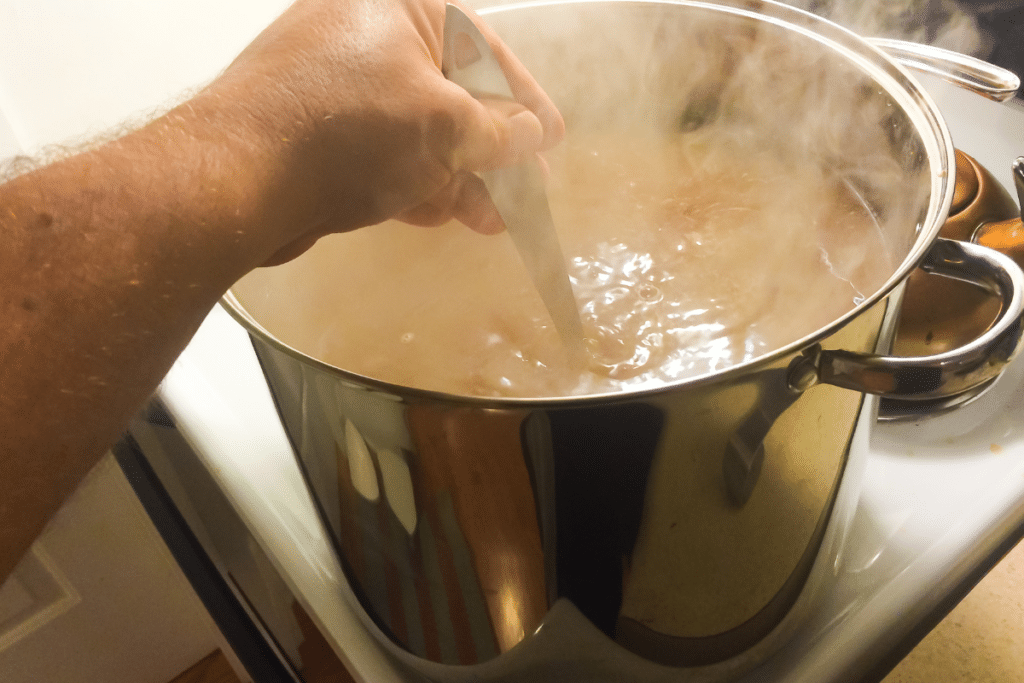Looking for a crisp, light, easy-drinking beer with a more complex flavor profile than hints of malt and corn? A Berliner Weisse offers tantalizing tartness with the light body of a lager. The question is how to brew a Berliner Weisse.
Brew a thirst-quenching Berliner Weisse with soft water that has light mineral additions. Fill the grain bill with wheat and pilsner malt. Pick German noble hops or similar varieties. Use a yeast that has good attenuation, medium flocculation, and little ester production. Sour with either Lactobacillus or lactic acid.
This delicate brew is challenging to get just right. Keep reading to learn how to achieve the best results. I’ll start by going over the style before we dive into the ingredients and process. After that, you’ll be ready to try out one of the homebrew recipes I’ve rounded up!
Topics We Cover
What is a Berliner Weisse?
A Berliner Weisse beer is a tart, slightly sour ale that Napoleon’s troops called the “Champagne of the North.”
A Berliner Weisse is a very light sour wheat beer. It is a pale yellow beer with high carbonation and soft malt flavors. These malt flavors tend to present as doughy or grainy. This helps balance the light sourness.

Defining characteristics of Berliner Weisse beers include:
- Color – 2-3 SRM (straw)
- Common flavor – Doughy, fruity, sour
- Aroma – Sour, fruity, malty
- Mouthfeel – Light, highly carbonated, crisp
- IBUs (Bitterness) – 3-8
- ABV – 2.8-3.8%
In addition to the main flavors of doughy malt and sourness, many Berliner Weisse beers will also have fruity flavors in the profile. This may include apple, apricot, or citrus. Any fruity flavors should not be overpowering.
The aroma should be similar with the sour notes being strongest. If present in the flavor profile, fruity notes should also be present in the aroma. Malt flavors can show up in the nose but are not as strong as the flavor.
A Berliner Weisse has a light mouthfeel that ideally doesn’t become too thin. It should be highly carbonated and can be clear or a little cloudy. This style is quite refreshing and crisp.
To many, it is an ideal “gateway” sour beer.
History of the Berliner Weisse beer
Unfortunately, the history of the Berliner Weisse is obscured by time and there are several theories regarding its origin.
It is most likely that the Berliner Weisse originated in Germany during the late 1500s or early 1600s, probably from a popular beer called Broyhan which was a similarly light sour beer.
Another potential origin comes from the Huguenots as they fled to Germany from France in the 1600s. This theory posits that the Huguenots picked up brewing traditions from other European countries that influenced the Berliner Weisse style.
Regardless of the exact origins, the style grew popular in northern Germany by the late 1800s. The style became popular enough that Napoleon gave it the title “Champagne of the North.”
Popular commercial Berliner Weisses
For the beer enthusiasts and the beer curious here’s a quick list of Berliner Weisse you should try.

- Dogfish Head Craft Brewery Festina Pêche – This beer focuses on the fruity notes of the style. That said, the peach flavors do not overwhelm the characteristic sourness.
- Bayerischer Bahnhof Berliner Style Weisse – Slightly softer than other examples of the style, this beer is a great blend of sourness, malt, and fruity flavors.
- Firestone Walker Brewing Co. Bretta Rosé – Another great fruity example. This beer brings raspberries to the crisp tartness of a Berliner Weisse.
- Night Shift Brewing Ever Weisse – Ever Weisse provides the delicious flavors of kiwi, hibiscus, and strawberries. This refreshing Berliner Weisse is masterfully balanced.
How to brew a Berliner Weisse
Once you’ve explored some great examples of the Berliner Weisse style you may be thinking of how to brew your own. In order to brew the best beer you need to know the style forward and backward. To that end, I will break down everything you need to know.
A Berliner Weisse begins with soft water that has a good balance of chlorides and sulfates. Simpler brews may start with 100% grain, but a more complex beer will also include Pilsner malts. This beer style isn’t heavy on the hops, so opt for a German noble hop or something mildly fruity. Use a yeast that has good attenuation, medium flocculation, and low ester production. Finally, you’ll want to add either Lactobacillus or lactic acid for the signature sour characteristics.
Let’s start by going over some great choices for the recipe and ingredients. Then, we can look at the process including brew day, fermentation, and bottling.
We add Lactobacillus intentionally when brewing a Berliner Weisse, but did you know it’s also one of the reasons your homebrew might taste sour when you weren’t (intentionally) brewing a sour beer?
Recipe and ingredients
While you can’t have beer without fermentation, you can’t get anywhere without quality ingredients. There are of course no wrong ingredients, but some will go together much better than others.
The recipes for this style typically use the same ingredients with some variation here and there:
- Water profile
- Base grains
- Specialty grains
- Hops
- Yeast
As always, start with your water. Since beer is nearly 90% water, good water makes good beer. Then consider your grain bill, hops, and finally yeast. Each one can have a significant impact on your final product.
Water profile
The best water profile for a Berliner Weisse is soft with a balanced chloride-to-sulfate ratio. The primary flavor is tartness which is less affected by water chemistry.
When experimenting with this style you can play with favoring chlorides or sulfates. A chloride lean will enhance the doughy malts while sulfates will enhance any bitterness. However, for a typical Berliner Weisse, you should keep both levels low.
As the typical grain bill is quite light, you may need to lower the mash pH. This can be achieved by adding acid to the water or acidulated malt to the grain bill.
If you are not doing an all-grain or partial brew, you don’t need to worry about adding any acid yet. When you get to souring the beer this is one option.
Base grains
This style is incredibly light in color and subtle in malt flavor. To this end, you don’t need much more than your base grains. The wheat will make up the majority of your grain bill. The pilsner malt can be up to 50% of the grain bill.
The best base grains to use in a Berliner Weisse include wheat malt and Pilsner malt.
It is an option to simply do 100% wheat malt as well. This will result in a simpler malt flavor profile. Adding at least some percentage of pilsner malt will add some subtle depth.
Specialty grains or other additions
Berliner Weisse doesn’t call for much if any specialty grains.
The only common specialty grain is acidulated malt.
The grain bill for this style is incredibly simple. The two base grains will do everything needed in this beer.
Hops
Berliner Weisse does not typically have hop flavors or aromas.
Some homebrewers may add hops for the fruit notes, but this is not essential. Choose hops with low alpha acid concentrations and subtle flavors.
German noble hops are usually the best choice but are not the only option. Look for hops that are similar to the German noble hops.
No matter the hops you choose, use them in small quantities so as to not over hop the beer.
Bittering
Bittering hops added early in the boil will go through a process called isomerization. This is what gives a beer its bitterness.
A Berliner Weisse calls for anywhere from 3 to 8 IBUs. Since this is not a high IBU count you need hops with low AA concentrations or small quantities.
Here are some good choices for bittering hops.
| Name | Purpose | Alpha Acid % |
|---|---|---|
| Name | Purpose | Alpha Acid % |
| Tettnang | Flavor + Aroma | 2.5-5.5% |
| Saaz | Flavor + Aroma | 2.5-4.5% |
| Spalt | Flavor + Aroma | 2.5-5.7% |
| Hallertau Mittelfrüh | Flavor + Aroma | 3.5-5.5% |
Aroma and flavor
Aroma and flavor hops added towards the end of the boil don’t add much bitterness. Instead, they add oils that provide flavor and aroma.
Berliner Weisse beers can make use of a small mid-boil addition to add bitterness and flavor.
Here are a few good choices to get you started.
| Name | Flavor/Aroma | Alpha Acid % |
|---|---|---|
| Tettnang | Woody, floral, citrus, cream | 2.5-5.5% |
| Saaz | Woody, floral, citrus, cream | 2.5-4.5% |
| Hallertau Mittelfrüh | Herbal, woody, floral | 3.5-5.5% |
| Cascade | Floral, citrus | 4.5-7% |
Yeast
The best yeast to use in a Berliner Weisse is one that has medium attenuation, low to medium flocculation, and low ester production. Generally, you want a clean fermenting yeast.
In addition to a basic yeast strain, this style needs a bacteria called Lactobacillus. This bacteria is the primary way to sour a Berliner Weisse. Lactobacillus is sold by several brewer’s yeast stores such as Wyeast.
Another yeast that is commonly used in sour beers is Brettanomyces. This yeast will add some additional flavors that truly improve the beer.
Dry
Below are some good dry yeast options for a Berliner Weisse.
| Name | Attenuation | Flocculation | Temperature Range |
|---|---|---|---|
| SafAle US-05 | 78-82% | Medium | 64-78°F |
| Lallemand WildBrew Philly Sour* | High | High | 68-77°F |
| SafAle K-87 | 80-84% | Low | 64-78°F |
*Also produces lactic acid
Liquid
Below are some good liquid yeast options for a Berliner Weisse.
| Name | Attenuation | Flocculation | Temperature Range |
|---|---|---|---|
| Wyeast 1007 | 73-77% | Low | 55-68°F |
| WLP630* | 73-80% | Medium | 68-72°F |
| WLP029 | 72-78% | Medium | 65-69°F |
*Also produces lactic acid
Brewing process
After acquiring all of your ingredients, you can move on to brew day. What you do on brew day can have just as much impact on your results as your choices of ingredients. On brew day, one of the most important aspects is sanitization. Be thorough when sanitizing.
All-grain, partial, and extract brewing each have important considerations for you to make. When doing all-grain or partial brewing you need to consider mashing and sparging. From there the other considerations are similar. The boil step and on is the same for all three.
Let’s break down each step with the Berliner Weisse in mind.
Mashing
This temperature range for the mash will ensure that the majority of the starches are converted into easily fermentable sugars.
The mash for a Berliner Weisse should be at least an hour long and between 150°F and 154°F.
Traditional approaches call for a step mash. While this gives greater control over the wort, it is not necessary.
Boil
After the mash and lauter, prepare for the boil. With this style, you have a few extra considerations.
With a Berliner Weisse, you have two options for souring the beer and the boil:
- You can perform a quick 15-minute boil, pitch Lactobacillus, let the bacteria work, then perform a full boil; or
- You can perform a bull boil, pitch Lactobacillus, let it work, then rack to the fermenter, then pitch yeast.
The first method ensures that the Lactobacillus has the best environment to chew through the available sugars and create lactic acid. This is because you won’t add any hops until the full boil. Lactobacillus does not do well with hops so if your brew is even a little too hopped it will struggle.
The second method will still work well as long as your batch is not overly hopped. It also allows the Lactobacillus to survive in your keg or bottles. This can result in a small amount of additional lactic acid production.

For both methods, it is important to keep the wort at a temperature comfortable for the Lactobacillus while it works.
As for the boil itself, it will be a standard hour-long boil. You won’t have many hop additions as the IBU range is quite low.
Whirlpool or flameout
After the boil for your Berliner Weisse, you can whirlpool.
This step is not essential to the style though it can help collect any trub. Some recipes use this time to add some hops for flavor.
While adding hops to the whirlpool can add flavor and aroma it won’t be necessary for this style. Any flavor you’ll need can be added during the boil.
Fermentation
When fermenting a Berliner Weisse you should keep the temperatures in the middle of your yeast’s preferred range. If using yeast blended with Lactobacillus, keep the temperatures on the higher end.
Keeping the fermentation temperatures consistent is key to brewing quality beer. Keep the temperatures in the mid-range for the majority of the process. Fermentation is pretty typical for this style.
Temperatures
The recommended temperature for primary fermentation is around 65°F to 70°F for a Berliner Weisse. When it comes to the Lactobacillus, keep the temperatures between 95°F and 100°F.
Keep in mind that lower temperatures can help reduce ester production while higher temps increase production. You don’t want much ester production, but a little won’t hurt.
Lactobacillus requires much higher temperatures to be at peak performance. This can be a struggle to maintain when you pitch it in your fermenter. One method is to wrap your fermenter in an electric blanket.
Bottling or kegging
The debate between bottling and kegging is strong for some styles but not for Berliner Weisse.
Bottling or kegging both work well for a Berliner Weisse. There is no style preference one way or another. Do what you find easiest. If you did not sour with Lactobacillus, you can instead add some lactic acid directly to the final product.
Adding the lactic acid directly can allow for more precise control but many brewers consider it to be lower quality than using Lactobacillus.
Berliner Weisse recipes
If you aren’t one to create your own recipes here are a few that you can follow for great results.

These recipes are from various brewers as credited below.
- Kettle Sour w/ Raspberry (All Grain)
- Tart Cherry Berliner Weisse (All Grain)
- Awesome Berliner Weisse Kettle Sour (Extract)
Kettle Sour w/ Raspberry (All Grain)
This recipe comes from user Meatwad on Brewer’s Friend.
Ingredients
- US White Wheat – 4.5 lb
- German Pilsner – 4.5 lb
- Crystal hops – 1 oz
- Gypsum – 3.9 g
- Calcium Chloride – 0.33 g
- Phosphoric acid – 19.5 ml
- Lactic acid – 1.95 ml
- Raspberry – 4 lb
- SafAle US-05
Method
- Heat 6.5 gallons to 150°F.
- Add grain bill and mash for 1 hour. Add the gypsum, calcium chloride, phosphoric acid, and lactic acid right away.
- Mashout.
- Collect 6 gallons of wort.
- Boil for 60 minutes. Add the hops immediately.
- Flameout and transfer to the fermentor.
- Cool and pitch yeast.
- Maintain 68° F during fermentation.
- Transfer to secondary. Add the chopped raspberries. Let sit for 5 days.
- Rack to keg or bottles. Enjoy!
Tart Cherry Berliner Weisse (All Grain)
This recipe comes from user NickMichaud on Brewer’s Friend.
Ingredients
- German Pilsner – 5 lb
- German Wheat Malt – 2.5 lb
- Tettnang hops – 0.5 oz
- Hallertau hops – 1 oz
- Cherry juice – 28 oz
- Lactobacillus culture
- WLP029
Method
- Heat 3 gallons to 150°F.
- Add grain bill and mash for 1 hour.
- Mashout.
- Collect 8 gallons of wort.
- Boil for 15 minutes.
- Cool to Lactobacillus temperature.
- Pitch Lactobacillus. Maintain temp for a day or two.
- Boil for 1 hour.
- At 15 minutes left add the Hallertau.
- At 10 minutes left add the Tettnang.
- Flameout and transfer to the fermentor.
- Cool and pitch yeast.
- Maintain 65° F during fermentation.
- Transfer to secondary. Add the cherry juice. Let sit for 10 days.
- Rack to keg or bottles. Enjoy!
Awesome Berliner Weisse Kettle Sour (Extract)
This recipe comes from user Brewer #225738 on Brewer’s Friend.
Ingredients
- DME Pilsen – 2 lb
- DME Wheat – 2 lb
- German Pilsner – 1 lb
- German Wheat Malt – 1 lb
- Hallertau hops – 0.5 oz
- Sorachi Ace hops – 0.5 oz
- Lactic acid – 5 ml
- Wyeast 1007
Method
- Heat 3 gallons of water for your boil.
- Add the Pilsner and wheat malt when the water is around 140°F.
- Remove the flaked corn when the water is around 170°F.
- Cool to 100° F and add the malt extract and the acid.
- Maintain temperature for 24 hours.
- Bring to a boil for 60 minutes.
- At 15 minutes left add the hops.
- Flameout.
- Add water to reach 5.5-gallon batch size. Then transfer to the fermenter.
- Cool and pitch yeast.
- Maintain 65°F during fermentation.
- After fermentation, rack to keg and force carbonate or bottle condition.





